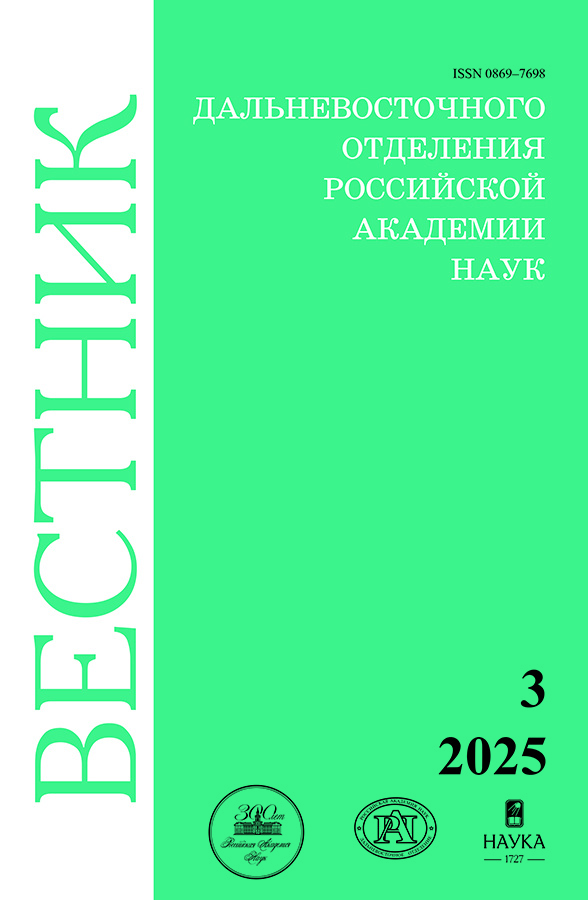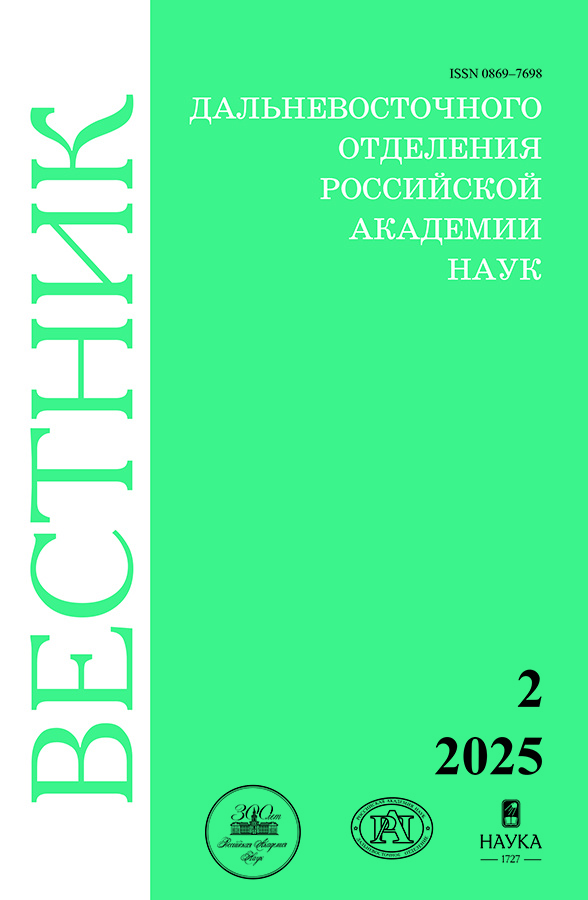Неинвазивные оптические методы (спектрометрия, тепловидение) при определении дефицита азота и физиологического состояния пшеницы в полевых условиях
- Авторы: Русаков Д.В.1, Канаш Е.В.1, Чесноков Ю.В.1
-
Учреждения:
- Агрофизический научно-исследовательский институт
- Выпуск: № 2 (2025)
- Страницы: 124-137
- Раздел: Биологические науки
- URL: https://permmedjournal.ru/0869-7698/article/view/687319
- DOI: https://doi.org/10.31857/S0869769825020094
- EDN: https://elibrary.ru/GEIDEE
- ID: 687319
Цитировать
Полный текст
Аннотация
Спектры отражения и температура поверхности листьев были измерены в полевом опыте при выращивании пшеницы сорта Дарья на Меньковской опытной станции Агрофизического НИИ. Растения вегетировали при различных уровнях азотного питания (0–200 кг/га с шагом 40 кг/га). Удобрения вносили в 2 этапа: 2/3 дозы азота (азофоска) перед посевом и 1/3 (аммиачная селитра) на стадии завершения кущения. Анализ индексов диффузного отражения поверхности листьев выявил тесную положительную взаимосвязь индекса хлорофилла (ChlRI) и тесную отрицательную взаимосвязь фотохимического индекса отражения (PRI) c дозой внесенных азотных удобрений на ранних этапах возникновения дефицита азота, когда видимые симптомы угнетения растений еще отсутствуют. Индексы отражения SIPI, R800, ARI и FRI помимо оценки обеспеченности растений азотом могут быть полезны при оценке специфический ответной реакции растений на действие различных стрессоров, например на дефицит почвенной влаги или недостаток почвенного азота. Использование тепловизионной съемки позволило оценить транспирационную активность растений пшеницы в зависимости от уровня азотного питания и ее изменение в течение дня.
Ключевые слова
Полный текст
Об авторах
Дмитрий Валерьевич Русаков
Агрофизический научно-исследовательский институт
Автор, ответственный за переписку.
Email: rdv_vgsha@mail.ru
ORCID iD: 0000-0001-8753-4440
Кандидат сельскохозяйственных наук, старший научный сотрудник
Россия, Санкт-ПетербургЕлена Всеволодовна Канаш
Агрофизический научно-исследовательский институт
Email: ykanash@yandex.ru
ORCID iD: 0000-0002-8214-8193
Доктор биологических наук, главный научный сотрудник
Россия, Санкт-ПетербургЮрий Валентинович Чесноков
Агрофизический научно-исследовательский институт
Email: yuv_chesnokov@agrophys.ru
ORCID iD: 0000-0002-1134-0292
Член-корреспондент РАН, доктор биологических наук, директор
Россия, Санкт-ПетербургСписок литературы
- Dobrowski S.Z., Pushnik J.C., Zarco-Tejada P.J., Ustin S.L. Simple reflectance indices track heat and water-stress induced changes in steady-state chlorophyll fluorescence at the canopy level // Remote Sensing of Environment. 2005. Vol. 97 (3). P. 403–414. doi: 10.1016/j.rse.2005.05.006.
- Rosso P.H., Pushnik, J.C., Lay M., Ustin S.L. Reflectance properties and physiological responses of Salicornia virginica to heavy metal and petroleum contamination // Environmental Pollution. 2005. Vol. 137 (2). P. 241–252. doi: 10.1016/j.envpol.2005.02.025.
- Kanash E.V., Panova G.G., Blokhina S.Yu. Optical criteria for assessment of efficiency and adaptogenic characteristics of biologically active preparations // Acta Horticulturae. 2013. 1009 (ISHS). P. 37–44. doi: 10.17660/ActaHortic.2013.1009.2.
- Graeff S., Claupein W. Quantifying nitrogen status of corn (Zea mays L.) in the field by reflectance measurements // European Journal of Agronomy. 2003. Vol. 19 (4). P. 611–618. doi: 10.1016/S1161-0301(03)00007-8.
- Kanash E.V., Osipov Y.A. Optical signals of oxidative stressin crops physiological state diagnostics. Precision agriculture Wageningen. Netherlands, 2009. P. 81–89. doi: 10.3920/978-90-8686-664-9.
- Yakushev V., Kanash E., Rusakov D., Blokhina S. Specific and non-specific changes in optical characteristics of spring wheat leaves under nitrogen and water deficiency // Advances in Animal Biosciences: Precision Agriculture. 2017. Vol. 8 (02). P. 229–232. doi: 10.1017/S204047001700053X.
- Yakushev V.P., Kanash E.V. Evaluation of wheat nitrogen status by colorimetric characteristics of crop canopy presented in digital images // Journal of Agricultural Informatics. 2016. Vol. 7(1). P. 65–74. doi: 10.17700/JAI.2016.7.1.268.
- Sims D.A., Gamon J.A. Relationships between leaf pigment content and spectral reflectance across a wide range of species, leaf structures and developmental stages // Remote Sensing of Environment. 2002. Vol. 81(2/3). P. 337–354. doi: 10.1016/S0034-4257(02)00010-X.
- Merzlyak M.N., Solovchenko A.E., Smagin A.I., Gitelson A.A. Apple flavonols during fruit adaptation to solar radiation: spectral features and techniques for non-destructive assessment // Russian Journal of Plant Physiology. 2005. Vol. 162 (2). P. 151–160. doi: 10.1016/j.jplph.2004.07.002.
- Penuelas J., Baret F., Filella I. Semi-empirical indices to assess carotenoids/chlorophyll a ratio from leaf spectral reflectance // Photosynthetica. 1995. Vol. 31 (2). P. 221–230.
- Gamon J., Penuelas J., Field C. A narrow-waveband spectral index that tracks diurnal changes in photosynthetic efficiency // Remote Sensing of Environment. 1992. Vol. 41 (1). P. 35–44.
- Rusakov D.V., Kanash E.V. Spectral characteristics of leaves diffuse reflection in conditions of soil drought: a study of soft spring wheat cultivars of different drought resistance // Plant. Soil and Environment. 2022. Vol. 68. (3). P. 137–145. doi: 10.17221/483/2021-PSE.
- Xu H., Ying Y. Application of infrared thermal imaging in the identification of citrus on trees // Journal of Infrared and Millimeter Waves. 2004. Vol. 23. P. 353–356.
- Möller M., Alchanatis V., Cohen Y., Meron M., Tsipris J., Ostrovsky V. Use of thermal and visible imagery for estimating crop water status of irrigated grapevine // Journal of Experimental Botany. 2007. Vol. 58. P. 827–838. doi: 10.1093/jxb/erl115.
- Xu J., Lv Y., Liu X., Dalson T., Yang S., Wu J. Diagnosing Crop Water Stress of Rice using Infrared Thermal Imager under Water Deficit Condition // International Journal of Agriculture and Biology. 2015. Vol. 18. P. 565–572. doi: 10.17957/IJAB/15.0125.
- Ghazouani H., Capodici F., Ciraolo G., Maltese A., Rallo G., Provenzano G. Potential of Thermal Images and Simulation Models to Assess Water and Salt Stress: Application to Potato Crop in Central Tunisia // Chemical Engineering Transactions. 2017. Vol. 58. P. 709–714. doi: 10.3303/CET1758119.
- García-Tejero I.F., Rubio A.E., Viñuela I., Hernández A., Gutiérrez-Gordillo S., Rodríguez-Pleguezuelo C.R., Durá-n-Zuazo V.H. Thermal imaging at plant level to assess the crop-water status in almond trees (cv. Guara) under deficit irrigation strategies // Agricultural Water Management. 2018. Vol. 208. P. 176–186. doi: 10.1016/j.agwat.2018.06.002.
- Vieira G.H.S., Ferrarezi R.S. Use of Thermal Imaging to Assess Water Status in Citrus Plants in Greenhouses // Horticulturae. 2021. Vol. 7 (8), 249. doi: 10.3390/horticulturae7080249.
- Trentin R., Zolnier S., Ribeiro A., Steidle Neto A.J. Transpiration and leaf temperature of sugarcane under different matric potential values // Engenharia Agricola. 2011. Vol. 31 (6). P. 1085–1095. doi: 10.1590/s0100-69162011000600006.
- Gardner B.R., Blad B.L., Watts D.G. Plant and air temperatures in differentially irrigated corn // Agricultural Meteorology. 1981. Vol. 25. P. 207–217.
- Jackson R.D. Canopy temperature and crop water stress // Advancesin Irrigaton. 1982. P. 43–85. doi: 10.1016/b978-0-12-024301-3.50009-5.
- Testi L., Goldhamer D.A., Iniesta F., Salinas M. Crop water stress index is a sensitive water stress indicator in pistachio trees // Irrigation Science. 2008. Vol. 26. 395–405. doi: 10.1007/s00271-008-0104-5.
- Grant O.M., Tronina L., Jones H.G., Chaves M.M. Exploring thermal imaging variables for the detection of stress responses in grapevine under different irrigation regimes // Journal of Experimental Botany. 2007. Vol. 58. P. 815–825. doi: 10.1093/jxb/erl153.
- Reynolds M.P., Dreccer F., Trethowan R. Drought-adaptive traits derived from wheat wild relatives and landraces // Journal of Experimental Botany. 2007. Vol. 58. P. 177–186. doi: 10.1093/jxb/erl250.
- Leinonen N., Jones H.G. Combining thermal and visible imagery for estimating canopy temperature and identifying plant stress // Journal of Experimental Botany. 2004. Vol. 55, No. 401. P. 1423–1431. doi: 10.1093/JXB/ERH146.
- Araus J.L., Slafer G.A., Reynolds M.P., Royo C. Plant Breeding and Drought in C3 Cereals: What Should We Breed For? // Annals of Botany. 2002. Vol. 89. P. 925–940. doi: 10.1093/AOB/MCF049.
- Chesnokov Y.V., Kanash E.V., Mirskaya G.V., Kocherina N.V., Rusakov D.V., Lohwasser U., Börner A. QTL mapping of diffuse reflectance indices of leaves in hexaploid bread wheat (Triticum aestivum L.) // Russian Journal of Plant Physiology. 2019. Vol. 66. P. 77–86. doi: 10.1134/S1021443719010047.
Дополнительные файлы











